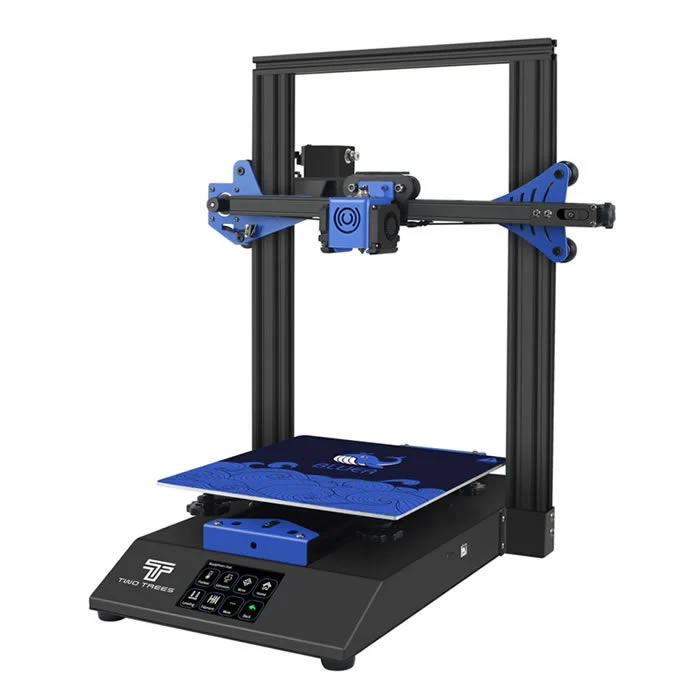Compare Bluer vs H2D
Comparison between the best 3D printers
Choose the best 3D printer at the best price. The cheapest 3D printers are here.
Buy a 3D printer here with 3D Fila.
 |
 |
|
| Model | Bluer |
H2D |
| Printing Material | Filament | Filament |
| Buy Filament for TwoTrees Bluer | Buy Filament forBambu Lab H2D | |
| Estimated price | $169,00 | $1899,00 |
| Manufacturer | TwoTrees | Bambu Lab |
| Release Year | 2019 | 2025 |
| Print Volume [mm] | 230x230x280 | 350x320x325 |
| Printer Size [mm] | 400x410x520 | 492x514x626 |
| Weight [kg] | 8 | 42,3 |
| Power Loss Recovery | YES | YES |
| Enclosed printer | NO | YES |
| Bed Leveling | Manual | Automatic |
| Filament End Sensor | YES | YES |
| Bed type | Heated | Heated |
| Power supply system | Bowden | Direct Drive |
| Standard nozzle | 0,4 | 0,4 |
| Maximum Nozzle Temperature [°C] | 260 | 350 |
| Maximum Bed Temperature [°C] | 100 | 120 |
| Maximum printing speed [mm/s] | 200 | 600 |
| Filament holder | YES | YES |
| Camera for supervision | NO | NO |
| Recommended filaments | PLA, PETG | PLA, PETG, ABS, ASA, TPU, PVA, Nylon (PA) |
| Recommended slicers | Cura, Simplify, Slic3r | Bambu Studio |
| Maximum Resolution [mm] | 0,1 | 0,01 |
| Processor | MKS Robin Nano V1.2 + TMC2208 | |
| Display | Touchscreen TFT 3,5'' | Touchscreen 5'' |
| Power Supply | 240W | |
| Connectivity | SD / USB | Wifi, Bambu bus, Cartão SD |
| Operating systems | Windows, Mac, Linux | Windows, Mac, Linux |
| Date of registration in the system | 2021-09-20 | 2025-03-31 |
| Release date | 2019 | 2025 |
| Extra features | The Bluer offers interesting features such as automatic bed leveling, a 3.5-inch color touchscreen for easy operation, and a filament sensor to prevent print failures. It has a robust metal extruder and a generous 230 x 230 x 280 mm print volume, suitable for a variety of projects. The community mentions improvements made by Two Trees based on feedback, increasing its reliability. | Bambu Labs H2D combines high-speed 3D printing with a chamber heated up to 65 °C, dual extrusion with automatic nozzle switching, an AMS for filament drying and exchange, and AI sensors that detect failures. It offers optional laser and digital cutting capabilities, features intelligent calibration through computer vision, vibration control, enhanced fire safety, and real-time camera monitoring. |
| Support for multiple colors and materials (AMS and CFS) | NO | YES |
Notes * |
||
| Cost-benefit | 7 / 10 | 7 / 10 |
| Hardware | 2 / 10 | 7.2 / 10 |
| Tela | . | . |
| Print volume | 3 / 10 | 4 / 10 |
| Performance | 2 / 10 | 5 / 10 |
Conclusion |
| In comparing the TwoTrees Bluer and the Bambu Lab H2D 3D printers, several key factors highlight the distinct advantages and disadvantages of each model, catering to a variety of user needs. The TwoTrees Bluer, as an entry-level printer, offers substantial value for its lower price point, making it an accessible option for beginners and hobbyists. Its print volume of 230x230x280 mm and robust features such as a heated bed, a manual bed leveling system, and a filament end sensor provide ample functionality for standard 3D printing tasks. However, limited to basic materials like PLA and PETG, the Bluer appeals primarily to novice users instead of professionals seeking advanced features. On the other hand, the Bambu Lab H2D presents itself as a premium choice with significant advantages for advanced users and professionals. Its larger print volume (350x320x325 mm), a higher maximum nozzle temperature, automatic bed leveling, and the ability to work with a diverse range of filaments (including ABS, TPU, and Nylon) enhance its versatility. The printer is equipped with modern features like default Wi-Fi connectivity, sophisticated AI sensors for error detection, and intelligent calibration, positioning it strongly within the competitive landscape of professional-grade 3D printers. Despite the higher cost, the H2D's extensive capabilities and performance features justify its price for more serious 3D printing applications. However, users seeking a solid yet budget-friendly option may find the TwoTrees Bluer to be a suitable starting point. Ultimately, the decision between the TwoTrees Bluer and the Bambu Lab H2D hinges on the user's specific needs. Novice users or those requiring a budget-friendly solution may favor the Bluer for its simplicity and accessible price, while experienced users looking for speed, accuracy, and advanced features would be better served by the high-performance H2D, which offers a more robust and versatile print experience. |

